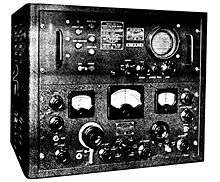Radio spectrum scope

RBY-1, US Navy Panoramic Radio Adapter RBY-1 with Hallicrafters SX-28. The Panoramic Radio Adapter is the upper part.
The radio spectrum scope (also radio panoramic receiver, panoramic adapter, pan receiver, pan adapter, panadapter, panoramic radio spectroscope, panoramoscope, panalyzor and band scope) was invented by Marcel Wallace and measures the magnitude of an input signal versus frequency within one or more radio bands - e.g. shortwave bands.[1][2] A spectrum scope is normally a lot cheaper than a spectrum analyzer, because the aim is not high quality frequency resolution - nor high quality signal strength measurements.
The spectrum scope use can be to:
- find radio channels quickly of known and unknown signals when receiving.
- find radio amateurs activity quickly e.g. with the intent of communicating with them.
References
- ↑ Panoramic radio receiving system US 2279151 A
- ↑ Chuck N7RHU: Panadapters Quote: "...The panoramic spectrum display, invented by Marcel Wallace in the 1930s, provides a radio operator with a graphic display of radio signal amplitudes at frequencies close to the signal to which his radio is currently tuned..."
External links
- Ham radio Band-scope pan-adapter using Tek MDO4000 as a spectrum analyzer on YouTube
- K9rod.net: Spectrum Scope
- ac8gy.com: Panadapter for FT-950
- k2za.blogspot.dk: FT-817 Tip - Spectrum Scope
- portabletubes.co.uk: Panoramic Radio Products PCA-2 Panadapter
This article is issued from Wikipedia - version of the 11/16/2015. The text is available under the Creative Commons Attribution/Share Alike but additional terms may apply for the media files.